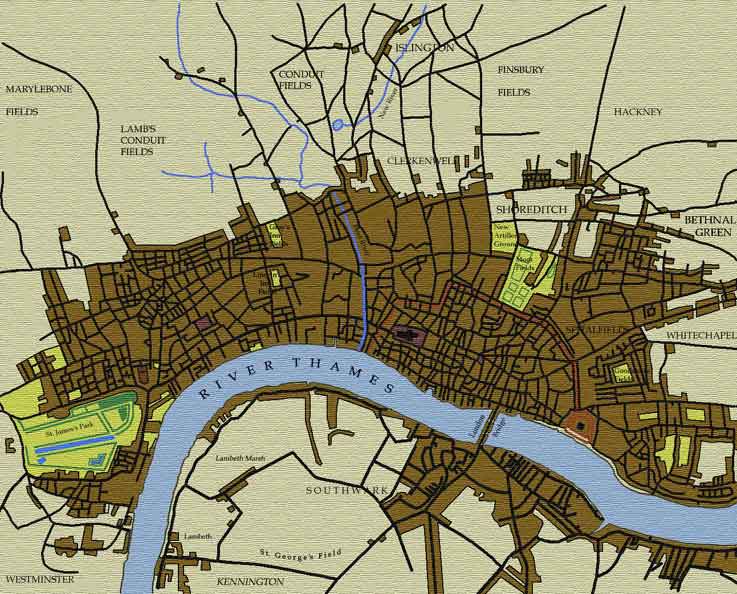


London ca. 1676
Covent Garden
|
Covent Garden was developed as a commercial enterprise
in 1631 by Francis Russell, the 4th Earl of Bedford, on land that had
been confiscated from the abbey of St. Peter at Westminster at the time
of the dissolution of the monasteries. (The name is, of course, a corruption
of "convent"; the piazza was built upon the site of the old
convent gardens). |
|
Intended as the centrepiece for a fashionable and
upscale residential neighbourhood, Bedford employed the foremost architect
of his day for its layout and design. Inigo Jones modelled the central
square upon the Italian piazza; its colonnaded design exhibits most obviously
the influence of the Italian architect Palladio. Jones surrounded the
square itself with arcades on two sides; at the west end sits his Tuscan-style
St. Paul's Church. In the streets immediately adjoining the square Bedford
had a number of graceful – and expensive – residential buildings
constructed; to service this new community, he issued licences for a fruit
and vegetable market, to be held in the centre of square. The entire development,
as originally laid out, covered approximately 40 acres. As intended, the new area rapidly
attracted further development, both in the form of new residential areas
associated with Bedford's development, and in the numerous high-end shops,
coffee-houses, and taverns that were soon opening near the square. By
the Restoration, Covent Garden was no longer on the periphery of London
development, as it had been when first constructed, but it was still,
by and large, an expensive area in which to live and shop. It is not coincidental
that the first theatres to built in the Restoration located themselves
near Covent Garden: quite aside from the area's convenience to both Court
and City, the area itself could boast a fair share of the fashionable,
theatre-going members of the public. Covent Garden represented, in fact,
a kind of centre-of-gravity for the "Town" and the Restoration
beau monde. John Strype noted in 1700 that the
area was "well inhabited by a mixture of nobility, gentry and wealthy
tradesmen . . . scarce admitting of any poor, not being pestered with
mean courts and alleys"; yet, by Strype's time, the area was already
undergoing a slow and painful transition. Ned Ward's London Spy,
published 1698-99, identifies the square – and St. Paul's Church
in particular – as a convenient rendezvous for married men and women
making assignations with lovers. More to the point, however, the fruit
and vegetable market established by Bedford had begun to affect the area
somewhat, attracting a crowd of increasingly less fashionable patrons.
By the mid-eighteenth century, the Covent Garden area had become run-down,
and was better known for its prostitutes than for its fops. The magistrate
Sir John Fielding (brother of the novelist) lived in the area himself
in the mid-eighteenth century, and commented that "one would imagine
that all the prostitutes in the kingdom had picked upon the rendezvous." Covent Garden served as the hub of fashionable London for most of the Restoration, and its importance did not entirely diminish in the eighteenth-century, as it remained near the heart of the theatre district. Its design, construction, and management are also noteworthy in that they represented a radical departure from Tudor practice. In particular, the use of a communal square or piazza as the centrepiece for a new residential development, and the employment of uniformly designed facades for expensive row houses, anticipate common eighteenth-century practice. So too did the financing of the development by Bedford: most of London's expensive new residential developments would, in the eighteenth-century, be conceived as lucrative investments under the control of aristocratic landowners.
|
 |
Website maintained by: Mark
McDayter
Website administrator: Mark McDayter
Last updated: April 25, 2002